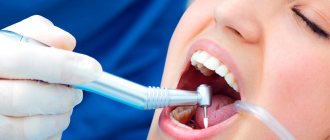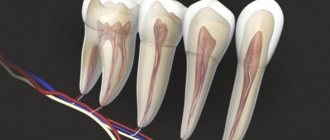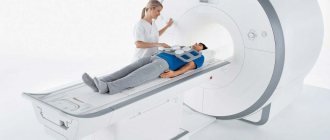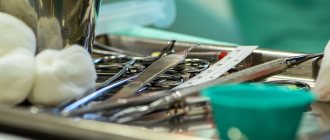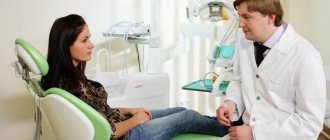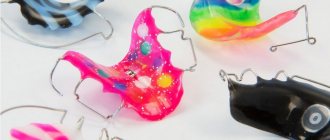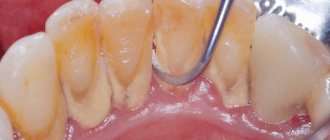Tooth depulpation is the removal of the pulp (popularly the removal of a nerve). Pulp is a bundle of blood vessels, lymphatic vessels, nerve endings and loose connective tissue that fill the tooth cavity and nourish it from the inside. Thanks to the pulp, the process of blood supply and mineralization of the tooth occurs. When the pulp is removed, these processes will not occur.
On average, a tooth with a nerve “lives” longer than a pulpless one. The dentist’s task is to save the pulp, if possible, because removing the nerve is a necessary measure of dental treatment. As an option, the patient is offered a more loyal solution - to preserve the nerve in the tooth and seal it, and in case of pain, depulpate it. Depulping a tooth allows you to save the tooth, but has some negative consequences:
- removal of the pulp deprives the tooth of mineralization and proper blood supply, which shortens its “life”;
- Tooth enamel becomes more fragile and fades, and the strength of the tooth decreases.
Depending on the damage to the pulp, the dentist decides on its complete or partial amputation. There are cases when you have to deal with advanced inflammatory processes that lead to severe destruction, when the nerve cannot be saved - the nerve must be removed.
Some patients try to avoid the depulpation procedure, preferring to endure the pain and/or take painkillers. This should not be done! In such cases, pulpitis can become chronic without any special manifestations - asymptomatic. And due to provoking factors, a purulent abscess may occur, which threatens the development of periodontitis.
Indications for depulpation
When should a dental nerve be removed?
- Advanced caries;
- Pulpitis – including asymptomatic;
- Severe tooth trauma – partial destruction of the tooth and exposure of the nerve;
- Preparation for prosthetic crowns (at the discretion of the orthopedic dentist);
- Periodontitis;
- Consequences of unsuccessful treatment;
- Unbearable pain.
Arsenic poisoning
Before doctors arrive, the victim should be induced to vomit. To do this, he is given 0.5-1 liter of clean water to drink, after which he is pressed with his fingers on the root of the tongue. The manipulation is carried out several times until a clean washing liquid begins to flow away, in which there are no foreign impurities. Next, the patient must be laid down and an influx of fresh air must be provided. For unconscious people, gastric emptying is contraindicated.
First aid
Acute arsenic poisoning requires first aid on the spot. The patient is advised to undergo gastric lavage using at least 10 liters of water mixed with adsorbent. After the procedure is completed, the patient is given 8-10 tablets of activated carbon and 50-100 ml of magnesium sulfate to drink as a laxative. An alternative is unithiol administered into the stomach through a tube. The same drug is infused intramuscularly.
At the prehospital stage, other measures are taken to maintain vital functions. To eliminate hypovolemia and correct electrolyte balance, infusion therapy is started. Anticonvulsants are used for seizures. In order to reduce pain, antispasmodics and analgesics are prescribed. Transfer to mechanical ventilation and titrated supply of vasopressors may be required.
Hospital treatment
Unithiol therapy continues in the hospital setting. The drug is prescribed in a course of 5-6 days. In its absence, the patient should receive N-acetylcysteine, which acts as a donor of monothiol groups. In case of damage by arsenous hydrogen, mecaptide is added to the regimen. Active methods of detoxification are required: intestinal lavage with the introduction of 8-10 liters of saline enteral solution into the intestines, hemodialysis, repeated gastric lavage.
After intestinal lavage is completed, the patient is given an antidiarrheal drug to drink. Infusion of saline solutions is required; in case of severe dehydration, infusion of colloids. Adult patients can receive fluids by mouth (rehydration solutions) as long as this does not cause vomiting. Additionally, glucocorticoids, ascorbic and nicotinic acid are prescribed. Severe metabolic acidosis is eliminated with sodium bicarbonate.
Recovery
After discharge from the hospital, the patient is recommended to be monitored by a local therapist to exclude the development of delayed consequences of chemical injury. It is possible to visit gastroenterological sanatoriums. Food must meet the requirements of table No. 4 according to Pevzner. Restrictions must be observed until the gastrointestinal tract is completely stabilized.
Contraindications for depulpation
When is it impossible to remove a dental nerve?
- stomatitis, inflammatory, purulent processes in the oral cavity;
- cardiovascular diseases;
- ARVI, sore throat, influenza;
- infectious hepatitis;
- hemorrhagic diathesis;
- acute leukemia;
- psychoemotional disorders;
- pregnancy.
Depulpation methods. How is the dental nerve removed?
Vital method
The vital depulpation method is used in adults and children - for all forms of pulpitis. This is a one-session procedure performed under local anesthesia. The dentist prepares the tooth, removes the pulp, cleans and fills the root canals, and then places a filling.
Devital method
The devital depulpation method is used to completely remove the coronal and root parts of the pulp. It differs from the vital method in the duration of treatment. An arsenic-free paste is applied to the pulp, after which a temporary filling is installed. The permanent filling is installed at your next visit to the dentist. In modern clinics, this method of treatment is used less and less.
Regardless of the method, the depulpation procedure is always carried out under anesthesia and the use of x-ray control of the tooth before and after depulpation. In 99% of cases, the vital method is used, in which complete, painless dental treatment can be completed in just one visit to the doctor.
From the history of depulpation or how were dental nerves removed before?
Depulping with arsenic is an outdated, quite painful and time-consuming method. The essence of depulpation with arsenic is that the dentist, using a dental drill, expands the root canal of the diseased tooth, opening direct access to the pulp. Then arsenic is placed in the canal and the tooth is covered with a temporary filling. Within a few days, arsenic affects the pulp, causing its death. A few days later, the patient visits the dentist again, who removes the temporary filling and removes the dead nerve from the canal. Then the dentist cleans the root canal and places a permanent filling. If the tooth continues to hurt after removing the nerve, the nerve may not have been completely removed. If pain after depulpation is caused by improper treatment and/or poor-quality canal treatment, the patient needs to visit the dentist again.
One of the main disadvantages of depulping with arsenic is its unsafety. With prolonged contact with a tooth, arsenic can lead to its complete destruction, because Arsenic is a poison, so arsenic paste was applied for a short period of time.
In modern dentistry, preference is given to safer methods of pulp removal.
Features of depulpation
Features of depulpation of baby teeth
It happens that pulpitis develops on baby teeth in children. In children, the depulpation procedure has its own characteristics:
- The minimum dosage of anesthesia is safe for the child;
- Careful opening of the crown;
- The most careful removal of the nerve ending, so as not to damage the primary processes of the molars;
- Thorough disinfection after depulpation to avoid re-inflammation;
- A filling for a baby tooth (based on mummifying compounds) – gives a disinfecting effect.
Depulpation of wisdom teeth
The difficulty of removing nerves from wisdom teeth lies in the inaccessibility of the teeth and the complexity of the structure of their canals. Therefore, if inflammatory processes occur in the pulp of wisdom teeth, it is better to remove the wisdom teeth.
Possible complications of depulpation
Complications that may arise after depulpation appear for 2 reasons:
- Anatomical features of dental canals and pulp.
- Incorrectly performed depulpation procedure.
Anatomical features of dental canals and pulp
Often the dental canals are very curved, in such cases access to the pulp can be difficult and it is difficult for the dentist to reach the nerve. In this regard, the pulp may not be completely removed, or cavities may remain in the canals.
The use of X-rays allows us to study the shape of the canals before removing the nerve and select the most appropriate instruments, which minimizes the likelihood of the above-mentioned treatment complications.
Incorrectly performed depulpation procedure
- Careless cleaning of the canals will preserve and intensify the inflammatory process due to incomplete removal of damaged tissue.
- Using an inappropriate pulp extractor channel size or improper handling of the instrument.
- Broken dental instrument, retention of its remains in the dental canal (this error may lead to the need to remove the tooth).
- Residual pulpitis occurs against the background of incompletely removed pulp.
- Perforation of root walls;
- Allergic reaction to filling material.
Poor disinfection of the canal when removing the nerve can trigger the process of suppuration. Which, in the absence of adequate treatment, can develop into a periodontal abscess. Such a complication leads to the need for tooth extraction.
Other possible complications:
Painful sensations for several days after depulpation - the duration is individual for everyone. If pain persists for a long time, it is necessary to consult a doctor to re-open the canals and carry out disinfection.
Specific problems can arise if the material is applied incorrectly: if the filling extends beyond the boundaries of the root apex, the jaw nerve may be pinched.
Recommendations
Recommendations after depulpation:
- refuse, for at least 2 hours, increased physical activity;
- rinse your mouth with antiseptics prescribed by your doctor during the day;
- hold off on eating for the first 3 hours (drink boiled, warm water through a straw);
- give up smoking and alcohol for five days, also do not take (solid, hot/cold, spicy) foods that cause irritation of the mucous membrane;
- It is forbidden to drink cold drinks, ice cream, or apply ice to the affected area.
Prevention recommendations:
Regular teeth cleaning combined with systematic visits to the dental clinic is the best way to save yourself from the need to undergo a nerve removal procedure. A visit to the dentist once every six months will ensure timely treatment of caries and will not allow the carious process to penetrate too deeply into the tooth tissue and spread to the pulp.
Remember! There are no folk remedies for removing the dental nerve! Even if it is possible to “kill” the nerve, pulp removal is only possible by a qualified dentist using special instruments!
Number of views 3,328
We also recommend:
Tooth cyst - symptoms, treatment
Chewing gum: good or bad for teeth?
Alcohol and the effect on teeth
Modern people today actively drink alcohol in their daily lives. It is used for various holidays and celebrations. It is almost impossible to imagine wakes and funerals without it. People drink alcohol almost always and everywhere. But not everyone thinks about what kind of harm this poison causes to the body. First of all, the damage is done to the teeth. But what exactly and in what sizes is worth finding out in as much detail as possible.
Alcohol leaches calcium
The most important thing is that over time, alcohol leaches calcium from the human body. Namely, it is the basis for tooth enamel. Alcohol also contains a huge amount of harmful acids, and in some cases, artificial dyes. A person who frequently drinks alcohol gradually leaches beneficial substances from his body, which contributes to the appearance of caries and other dental problems. The whiteness of teeth also deteriorates, which also negatively affects the enamel.
Teeth become ugly and unattractive. Even with frequent cleaning, they will still have an unhealthy color. There are people who believe that if they eat wine with cheese, the enamel will not deteriorate, since dairy products contain some amount of calcium. In fact, the pervasive properties of the acids of wine and any other coloring alcoholic drink will still negatively affect the human body.
Immunity decreases, and hence the nutrition of the tooth
When a person drinks alcohol frequently, his immune system gradually begins to weaken. For example, even just one glass of wine or any other strong drink begins to wash out the necessary vitamin A and B in the body, and the amount of zinc, calcium and iron decreases. The level of mineral salts and trace elements decreases, without which the functioning of the heart, brain and other organs is simply impossible. Thus, the human body experiences unprecedented stress that does not pass by. The body begins to produce special antibodies, which significantly reduce the level of immunity. A person begins to actively get sick, his mood deteriorates and nervous diseases begin. Therefore, they often say that people who drink are very nervous and aggressive. Metabolic processes inside the teeth are also disrupted, which gradually leads to the fact that they begin to hurt even more and gradually fall out.
Low alcohol is the hardest blow to the teeth
There are people who believe that if they drink low-alcohol drinks, the harm to health will be minimal. In fact, the opposite is true. Such drinks often contain a huge amount of sugars, which affect the appearance and health of teeth. Therefore, it is important to understand that excessive consumption of such drinks can lead to a lack of nutrients in tooth enamel. Over time, it will begin to break down, leading to toothache and enamel destruction.
Also, a huge amount of dyes contained will destroy and modify tooth enamel. It will gradually begin to corrode. Therefore, it is important to understand that such drinks harm the entire body as a whole. They also have a special effect on the stomach. For example, there is a certain relationship between the fact that people with stomach problems will gradually have problems with their teeth. This is caused by the fact that the human body receives a minimal amount of vitamin E and more cholesterol and fat. Such a diet has a bad effect on the condition of teeth too. Therefore, it is important to understand what exactly to eat and how exactly alcohol affects the general condition of your teeth.
Tooth removal
Depulpation (depulpation of a tooth) is the removal of pulp, connective tissue consisting of blood vessels and nerve endings. Removing the tooth nerve and cleaning the canals is designed to relieve the patient from pain, inflammation and further complications. However, the tooth, having lost its blood supply, becomes dead and, therefore, more fragile.
Dental treatment and nerve removal is one of the most common dental procedures. This is partly because patients turn to the dentist only in case of unbearable pain, when it is no longer possible to do without depulpation. Removing the nerve of the tooth and filling the canals allows you to preserve the natural tooth, which is a priority for endodontic treatment.
Indications for depulpation:
- extensive caries
- classic pulpitis and infectious pulpitis (bacteria penetrate through the root apex)
- trauma and damage to the tooth affecting the pulp
- if it is necessary to install crowns or classic bridges
Many patients who come to the dentist's office with toothache are interested in the question: is it possible to save the pulp? Today, there are methods of biological treatment (preservation of the entire pulp) and vital amputation (preservation of the root pulp), but many favorable factors must converge for them to be carried out. For example, biological treatment is not carried out after 25 years.


